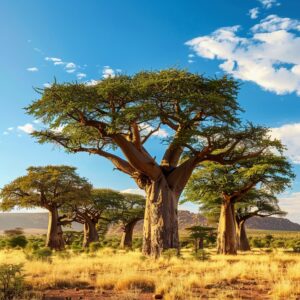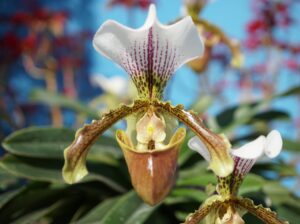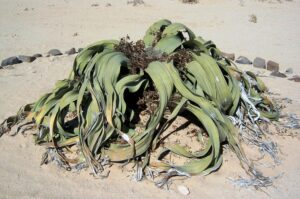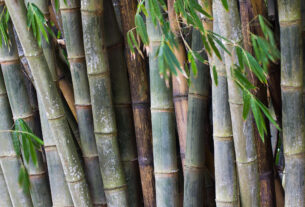Around the world, numerous plant species face the threat of extinction due to various human activities and environmental changes. Each of these species plays a vital role in their ecosystems, offering unique ecological benefits and often holding cultural significance. Understanding and preserving these plants is crucial not only for biodiversity but also for maintaining the balance of our natural world.
1. Rafflesia arnoldii

(commons.wikipedia)
Rafflesia arnoldii, known as the corpse flower, boasts the world’s largest individual flower, found in Southeast Asia’s rainforests. Lacking roots and leaves, it thrives as a parasitic plant within Tetrastigma vines, its massive blooms reaching over one meter in diameter and emitting a pungent odor to attract pollinators. Despite its biological marvels, Rafflesia arnoldii faces severe threats. Habitat loss due to deforestation for agriculture and urbanization, coupled with illegal harvesting for traditional medicine and commerce, endanger its existence.
Conservation efforts are critical, focusing on protecting its rainforest habitats through national parks and reserves. Ex situ conservation in botanical gardens preserves genetic diversity and supports research into its ecology. Community engagement and legislative protections aim to curb illegal harvesting and promote sustainable tourism.
Beyond its ecological role, Rafflesia arnoldii holds cultural significance and supports local economies through ecotourism. By addressing these challenges collaboratively, we can ensure this remarkable species continues to thrive in Southeast Asia’s biodiverse landscapes.
2. Baobab Trees (Adansonia Species)

(publicdomainpictures.net)
Baobab trees, part of the Adansonia genus, symbolize resilience in Africa and Madagascar’s arid regions. These iconic trees feature massive trunks up to 10 meters in diameter and provide vital ecosystem services like water storage and shelter during droughts.
Despite their importance, baobab trees face threats from climate change, including prolonged droughts and erratic rainfall. Habitat loss due to agriculture, logging, and urbanization further jeopardizes their survival. Illegal harvesting for wood and bark also disrupts populations.
Conservation efforts focus on establishing protected areas and community-led initiatives. Promoting sustainable land practices and raising awareness about their ecological and cultural significance are critical. These efforts aim to ensure baobab trees thrive for future generations, preserving their iconic status and ecological roles in arid landscapes.
3. Lady’s Slipper Orchids (Cypripedium spp.)

(Flickr/Elias_Rovielo)
Lady’s Slipper Orchids, part of the Cypripedium genus, grace temperate regions with their rare, slipper-shaped flowers, revered for intricate blooms that trap pollinators. However, habitat destruction and illegal collection threaten them.
Urbanization, agriculture, and land development fragment their habitats, while illegal harvesting disrupts pollination. Climate change worsens these issues by altering ecological niches and flowering times.
Conservation activities focus on habitat protection and public awareness. It is critical to establish protected areas, put legislative safeguards in place, and promote sustainable land practices. Engaging communities and promoting conservation in botanical gardens helps to protect these orchids.
4. Welwitschia mirabilis

(Flickr/Peter_Kosina)
Welwitschia mirabilis, endemic to the Namib Desert spanning Namibia and Angola, is a botanical marvel known for its longevity and adaptation. This plant, with its low, sprawling growth and two strap-like leaves, can live over 1,000 years. However, it faces threats from climate change and unsustainable tourism.
Climate change brings increased temperatures and altered rainfall patterns, challenging Welwitschia mirabilis’ survival in its harsh desert habitat. Unsustainable tourism, driven by interest in the desert’s flora, leads to habitat degradation and unauthorized collection.
The primary purpose of conservation efforts is to create protected areas in order to reduce human impact and preserve the desert ecosystem. Promoting sustainable tourism practices and educating tourists and communities about its environmental importance is critical. Research into the biology and responses to climate change informs conservation strategies for this ancient desert species.
5. Cycads (Encephalartos spp.)

(Flickr/Cody_Hinchliff)
Cycads, resembling palm trees, are ancient plants native to Africa, renowned for their resilience and longevity spanning millions of years. They play vital roles in their ecosystems but face severe threats from habitat loss, overharvesting for horticultural trade, and climate change.
Rapid agricultural expansion, urban development, and deforestation fragment and diminish cycad habitats. Illegal harvesting further depletes populations critical for biodiversity and ecosystem health. Climate change exacerbates these challenges by altering local climates, impacting cycad growth and reproduction.
Protected area creation, upholding legal safeguards against unauthorized harvesting, and encouraging sustainable land use are the main objectives of conservation initiatives. Conservation in botanical gardens is aided by research on the biology and propagation of cycads. To ensure the survival of these ancient plants amid Africa’s shifting landscapes, it is imperative to educate the public about their ecological significance and include local populations in conservation initiatives.
6. Pitcher Plants (Nepenthes spp.)

(Flickr/Geoff_Mckay)
Pitcher plants, from the Nepenthes genus, are carnivorous marvels found in Southeast Asia and tropical regions. Their distinctive pitcher-shaped traps lure and digest insects, supplementing nutrient-poor soils in their habitats.
Despite their ecological importance, pitcher plants face threats from habitat destruction and illegal collection. Deforestation for agriculture, logging, and urban development fragments their habitats, diminishing suitable environments. Illegal harvesting for horticulture further jeopardizes wild populations and disrupts natural pollination cycles.
Conservation efforts are centered on creating protected areas, maintaining tight legal prohibitions against unlawful collecting, and encouraging sustainable land usage. Conservation efforts in botanical gardens benefit from research on their ecology and propagation. Educating the public about their distinct adaptations and ecological responsibilities raises awareness and support for their protection in tropical settings, ensuring that these carnivorous wonders flourish for future generations.
7. Franklin Tree (Franklinia alatamaha)

(en.wikipedia.org)
The Franklin tree, Franklinia alatamaha, once native to the southeastern United States, is now extinct in the wild and survives only in cultivation. Discovered along Georgia’s Altamaha River in the late 18th century, it impressed early botanists with its fragrant white blooms and glossy foliage. Despite extensive searches, no wild populations have been found since its discovery.
The extinction of Franklinia alatamaha in the wild is attributed to factors like habitat destruction and disease. Its survival in cultivation is due to efforts by early plant enthusiasts who recognized its botanical importance and propagated it successfully.
Today, the Franklin tree remains prized in botanical gardens and collections globally. Conservation efforts focus on maintaining genetic diversity through cultivation. Ongoing research explores its ecology and potential strategies for future reintroduction, offering hope for its continued existence beyond cultivation.


